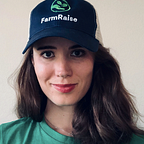A new farming fairy tale
How to get beginning farmers on the map
The story of the feudal land owner and the constrained farmer tenant is a tale as old as time. Over the weekend, the New York Times highlighted the obstacles Hudson Valley farmers face when seeking to purchase land, including sky-high premiums, competitive bids from urbanites with better access to capital, and misaligned expectations between farmer tenants and land owners who want the visual aesthetic of a farm without any of the smell, grit, and mess that inevitably characterize a working farm. While these wealthy landowners may have a ‘fairytale’ fascination with regenerative agriculture, these landowners have no interest in actually supporting a farm business.
We know this disconnect well at FarmRaise. Most of our customers are young farmers between the ages of 35 and 44 who dream of acquiring land to launch or expand their operations. Land ownership provides massive competitive advantages in farming, including a longer and healthier time horizon to reach profitability, agricultural tax credit cash flow, and realizable financial gains of sustainability practices that improve soil health. There are also unquantifiable benefits of ownership that farmers experience: cultivating a sense of place and a nuanced understanding of the biological community that underpins the land that they work. Time and experience brings these benefits into relief, and the typical short-term farming leases of a few years just won’t cut it.
Ownership can be a charged word in U.S. agriculture and land studies, especially given the historical context and diverse worldviews of the Indigenous peoples who lived in the Americas millennia before Westerners arrived. Sarah Mock and others advocate for a paradigm of more inclusive and shared land use in farming, and their work deserves more space and consideration than my short piece here. Today, I’ll focus on the incremental changes we can make within the existing system to bring opportunity and resilience to farming.
Acquiring land requires cash flow, flexibility, and speed. Today, when a cash-constrained beginning farmer bids against a wealthy urbanite, the urbanite will inevitably have faster access to capital to win the deal. As the New York Times reports, “such bidders often have a buyer’s advantage over farmers just starting out. That includes access to speedier loan options, whereas beginning farmers largely rely on slow-moving loans through the United States Department of Agriculture.” These loans are slow moving because the applications are complicated and require multiple steps, but they’re often great options for the farmer because they have lower interest rates than typical commercial loans. Fortunately, the speed challenge is one that technology can solve.
Instead of spending days calling around to different banks, getting rejected, and ultimately spending another week filling out farm records and an application for a USDA Farm Service Agency Loan, imagine if a farmer could — in less than 20 minutes — determine which loans they’re eligible for across several pre-vetted options, see their expected terms for their favorite packages, and submit a loan application. Once they’ve inputted that information, suddenly a whole library of funding programs and resources is available for the producer to access and invest in the land that they’ve successfully acquired through their initial loan. This is the vision we’ve hammered into a product over the spring at FarmRaise, and this product is the foundation we’re going to build upon to unlock new possibility for American farmers.
As you can tell, I’m really excited about how technology can change a small or beginning farmer’s experience, transforming towering constraints into tangible opportunity. This is just the beginning of a new fairy tale we’re writing at FarmRaise, a story in which the farmer is the protagonist and the sky’s the limit 🌱
